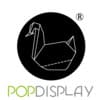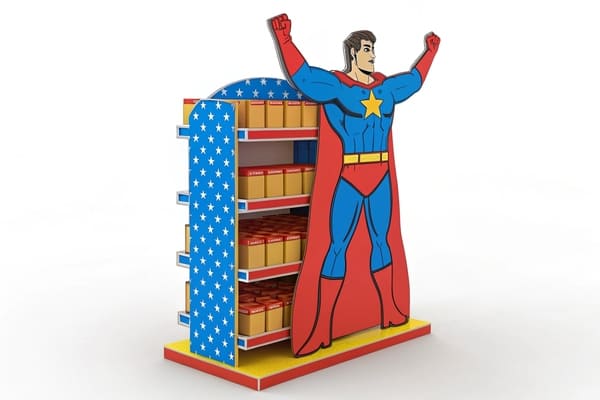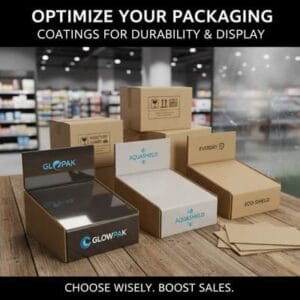I know you want clarity fast. You face deadlines. You need proof before you commit. I will keep this simple and direct.
Yes. I provide a physical sample after design approval, with free modifications until you confirm, and I run strength and transport tests before mass production to protect timelines and budgets.

I want you to see and touch the idea before you buy it. A good sample lowers risk, aligns teams, and keeps launches on track. I explain how I work and what you get.
What are cardboard displays called?
You see many names online. They sound similar. They can confuse buyers and engineers. I use clear terms and simple categories.
Cardboard displays are commonly called POP or POS displays, and include floor displays, countertop displays, pallet displays, shelf trays, and PDQ shippers for quick retail set-ups.
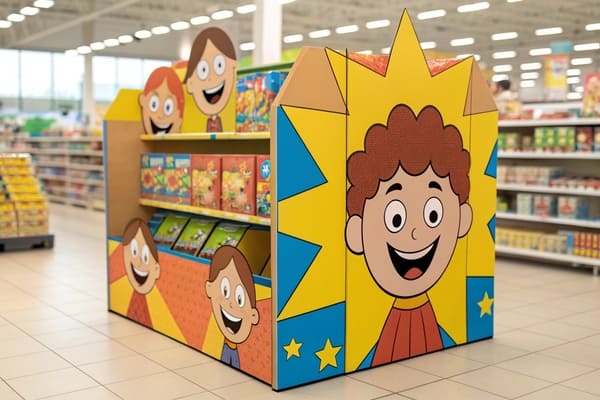
The core names and when I use them
I keep naming tight because clear names speed design reviews. A POP display1 sits near the point of purchase. A POS display2 sits at the point of sale. Most teams use POP and POS to mean the same thing. I map structures to tasks. A floor display stands alone and holds volume. A countertop display sits near checkout and drives impulse buys. A pallet display ships in and drops on the floor fast. A shelf tray sits in existing shelving and adds branding. A PDQ shipper travels prepacked and opens fast in stores. In my factory in Shenzhen, I keep templates for each family. This shortens prototyping. It also reduces waste. I learned this the hard way after a rollout that mixed names and delayed artwork. Since then, I align vocabulary first. This simple step saves days.
| Display Type | Typical Use | Setup Speed | Load Capacity | Ideal Location |
|---|---|---|---|---|
| Floor Display | New launches, bundles | Medium | High | Aisle or entrance |
| Countertop Display | Add-on, small packs | Fast | Low | Checkout counter |
| Pallet Display | High volume promos | Very fast | Very high | Warehouse clubs |
| Shelf Tray | Brand blocking on shelf | Fast | Medium | Existing shelving |
| PDQ Shipper | Prepacked quick set | Very fast | Medium | Multiple spots |
How to make a cardboard display stand?
You want a clear build path. You want no gaps between design and the line. I give you a simple method that I use daily.
Define goals, pick the structure, choose board grade, finalize print, prototype, test for load and transit, then lock die-lines and move to mass production.
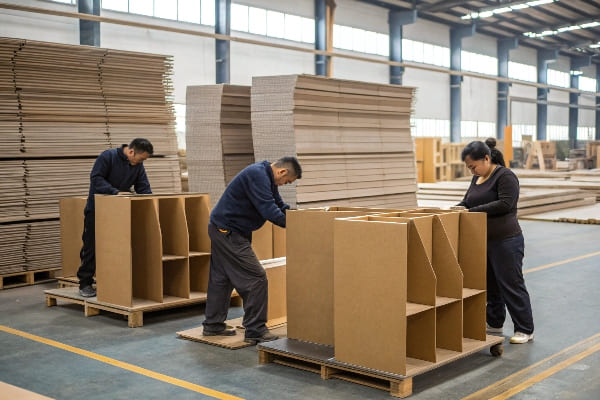
My step-by-step method that protects launches
I start with goals. What product, how many units, and how long in store. I set target load and retail footprint. I choose a structure from proven forms. I select board grade by weight and moisture risk. Single-wall E-flute is light and crisp for print. Double-wall BC-flute is strong for heavy items like crossbows or broadhead kits. I create a die-line and simple 3D rendering. I get fast feedback from your team. I print a prototype sample. I run a crush test3 and a vertical compression test. I do a quick drop test on the shipper. If needed, I add gussets, double tabs, or a hidden spine. I re-sample free until we hit the mark. In one hunting season project, I added a water-resistant nano-coating4 to survive a damp store entry. The display held shape for eight weeks and met sell-through. After approval, I lock barcodes and Pantone notes, then I open the tooling and plan the slotting time on one of my three lines. This routine keeps timing steady.
| Stage | Owner | Key Output | Typical Time |
|---|---|---|---|
| Brief | Buyer + Me | Goals, SKU count, budget | 24–48 hours |
| Structure | Me | Die-line + 3D view | 1–2 days |
| Prototype | Me | Printed sample | 2–4 days |
| Testing | Me | Load + transit results | 1 day |
| Final Art | Buyer | Print-ready files | 1–2 days |
| Production | Me | Mass run + QC | As scheduled |
What are cardboard display boxes?
Teams ask for boxes and displays in one breath. The terms can overlap. I draw a clear line so your spec is clean.
Cardboard display boxes are printed cartons that ship product and convert into a small display or tray, often called PDQ, shelf-ready, or counter units.
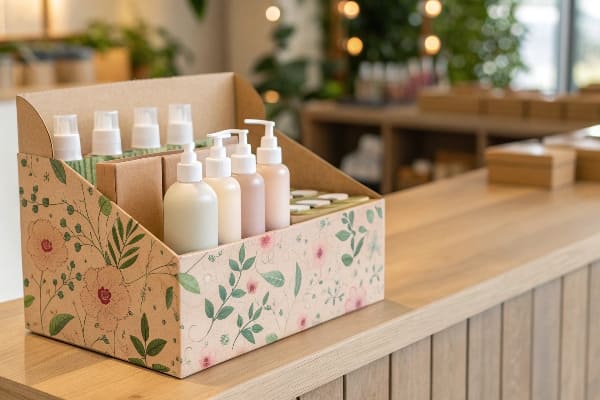
Why display boxes work and when I pick them
I use display boxes when speed matters. A shelf-ready carton5 ships closed. A merchandiser pops the lid, folds a header, and the box becomes a tray. This saves labor in stores. It also protects units in transit. For small hunting accessories like broadheads, wax, or string kits, a PDQ box6 is perfect. It keeps SKUs tidy and safe. Print wraps the carton, so the brand blocks well on shelf. I choose E-flute or F-flute for neat edges and tight curves. I spec tear-strips for clean opening. I lock tab geometry to avoid tearing front panels. I check inner pack count against planograms. I add a small angle on the front wall for sightlines. One lesson from a spring rollout: we once packed units too tight and edges bowed. I now add a 2–3 mm tolerance on inner width. This keeps trays square and stops scuffing during restock.
| Box Type | Use Case | Pros | Watchouts |
|---|---|---|---|
| PDQ/Counter Unit | Small items near checkout | Fast set, low cost | Limited load |
| Shelf-Ready | Aisle shelf brand blocking | Clean open, tidy facing | Needs precise tear lines |
| Tray + Header | Mid-shelf visibility | Bold message area | Header stability |
| Shipper-Display | Transit + display in one | Fewer touches, less waste | Outer strength required |
What is grey cardboard called?
Spec sheets often list a grey core. Buyers ask if it is recycled. I explain the term and when I use it.
Grey cardboard is usually called greyboard or chipboard; it is a recycled fiber board used for rigid backs, spacers, and cores where high print is not needed.
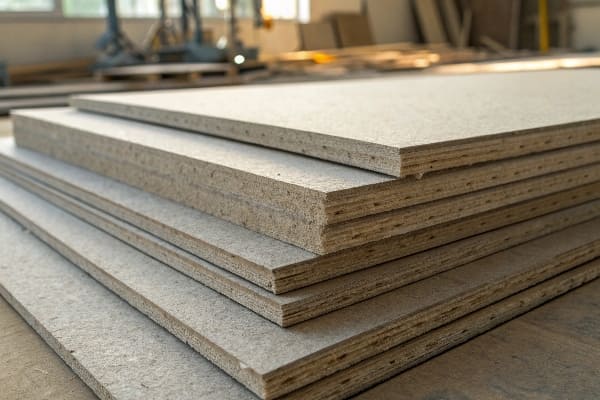
How I choose greyboard7 vs corrugated8
Greyboard or chipboard is dense and flat. It is great for headers, backers, and inserts. It resists bending on small parts. It prints okay with labels or mounted sheets. It does not crush like low-grade corrugated under point loads. Corrugated is lighter and better for larger bodies. It gives strength per weight. For displays that hold heavy metal gear, I may pair them. I build the body in BC-flute and add a greyboard spine or footplate. This stops leaning and keeps feet crisp on polished floors. I watch moisture. Greyboard can absorb water, so I add a water-based varnish or a PE-free barrier that stays recyclable. In one sports retail test, I replaced a plastic base with 2.5 mm greyboard laminated to E-flute. The cost fell. The display stayed straight for the full run. Buyers liked the solid feel and the lower waste.
| Material | Best Use | Strength/Weight | Print Quality | Recyclable |
|---|---|---|---|---|
| Greyboard | Backers, inserts, bases | High/High | Medium | Yes |
| E-flute | Small trays, headers | Medium/Low | High | Yes |
| BC-flute | Floor bodies, pallets | Very high/Low | Medium | Yes |
| F-flute | Premium small cartons | Low/Very low | Very high | Yes |
Conclusion
You get clear names, a simple build path, strong sampling, and material choices that match load, speed, and budget.
Understanding POP displays can enhance your marketing strategies and improve customer engagement at the point of purchase. ↩
Exploring POS displays will help you optimize sales strategies and boost impulse buying at the point of sale. ↩
Learn about crush tests to ensure your packaging can withstand pressure and protect your products effectively. ↩
Explore this link to understand how water-resistant nano-coatings can enhance product durability and performance. ↩
Explore this link to understand how shelf-ready cartons enhance efficiency and branding in retail. ↩
Learn about PDQ boxes and their advantages for organizing small items effectively in retail environments. ↩
Explore the benefits of greyboard in packaging to understand its durability and eco-friendliness. ↩
Learn about the strengths of corrugated materials for displays and how they can enhance your projects. ↩
